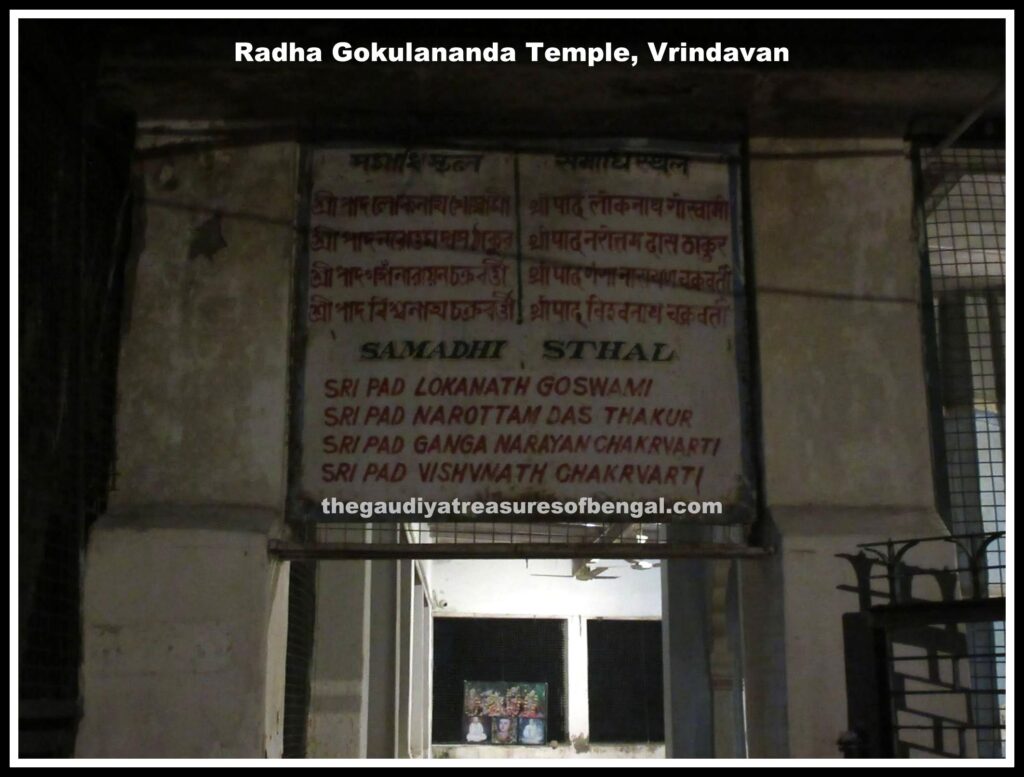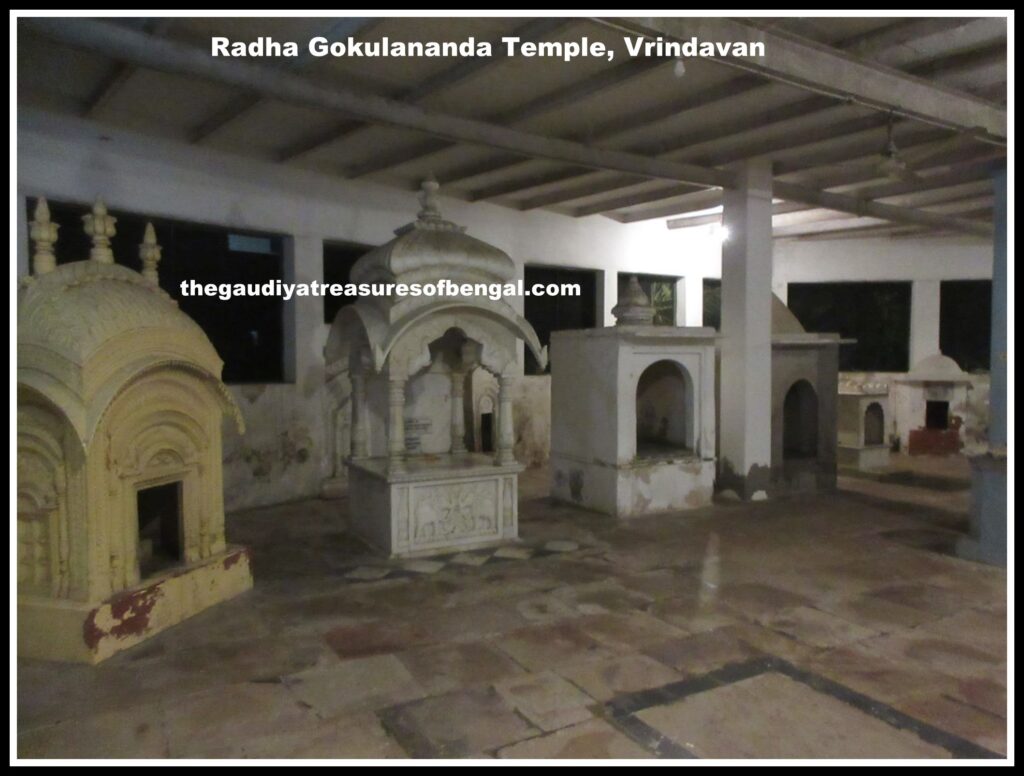
As the sun began to rise over the holy city of Vrindavan Mathura, the Radha Gokulananda Temple stood tall and proud near the Kesi ghat on the banks of the tranquil Yamuna River. The temple was a vision brought to life by the revered Viswanath Cakravarti, who saw the need to unite the deities of Radha-Vinoda, Vijaya Govinda, Radha Gokulananda, and Chaitanya Mahaprabhu under one roof. Walking through the temple’s doors, visitors were greeted by the small Radha-Vinoda Deities of Lokanatha Goswami, which were lovingly carved and meticulously adorned with precious jewels. Nearby, the larger deities of Vijaya Govinda of Baladeva Vidyabhusana towered above, exuding an air of regal elegance. And at the center of it all, stood the radiant Radha Gokulananda Deities of Viswanath Cakravarti, the very embodiment of divine grace and beauty.
It was said that before Viswanath Cakravarti’s vision, each of these deities were worshiped in their own separate temples. But he brought them together in one single temple, allowing devotees to pay their respects to all the deities at once. As one explored the temple further, they would come across the small deity of Krishna in front of Gokulananda and the Deity of Chaitanya Mahaprabhu, both of which were once worshiped by Narottama Dasa Thakur. And so, the Radha Gokulananda Temple stood as a testament to the power of grace, drawing in countless devotees from all over the world to bask in the divine presence of its sacred deities.
History of Radha Gokulananda Temple
Viswanath Chakravarti had always worshiped the Deity of Gokulananda at Radha Kunda, until he moved to Vrindavan and stayed with Lokanatha Goswami. It was in this very place that Lokanatha Goswami would do his bhajana. However, when the original temple of Radha Vinoda fell apart, Viswanath Cakravarti had another temple built and named it the Gokulananda Temple. From that time onwards, both his Deity of Gokulananda and Radha-Vinoda were worshiped here. Inside the temple, there is a special Govardhana sila that Lord Chaitanya had given to Raghunath Dasa Goswami. This sila bore the thumbprint of Lord Chaitanya and was always moist with His tears. Lord Chaitanya would chant while holding the sila, pressing it to His heart or eyes, and even place it on His head or smell it. After three years, He gave the sila to Raghunatha das, and it is now also worshiped at the Radha Gokulananda temple.

The original Deity of Radha-Vinoda is now being worshiped in Jaipur after being moved there to protect it from the Mughals’ attack on Vrindavana. The temple contains the pratibhu-murtis of the original Deities, and it is believed that there is no difference in potency between the original Deity and the pratibhu-murti. The samadhis of Lokanatha Gosvami, Narottama Dasa, and Visvanatha Cakravarti are situated in a small courtyard next to the temple, where Lokanatha Gosvami did his bhajana and left his body. In Narottama Das’s pushpa samadhi, his garland, kaupins, cloth, and mala are preserved, while Viswanath Cakravarti Thakura entered samadhi in the year 1674. The temple also houses the pushpa samadhis of Sri Ganga Narayana Chakravarti and Krishnadeva Sarvabhauma, who were disciples of Narottama das Thakur and Visvanatha Cakravarti, respectively. Krishnadeva had gone with Baladeva Vidyabhusana to Jaipur to uphold the rights of Gaudiya Vaishnavas to worship Govindaji.
Lokanatha Gosvami was a contemporary of Sri Chaitanya Mahaprabhu, and when Sri Chaitanya took sannyasa, Lokanatha came to Vrindavana. While visiting the places of Krishna’s pastimes, Lokanatha Gosvami discovered the Deity of Radha-Vinoda in the village of Umaraa in the forest called Chatavana. The Deity was revealed to him from the Kishori Kunda, and he used to carry this Deity in a bag hanging from his neck. Lokanatha’s samadhi is just north of the village of Umaraa, on the bank of Kishori Kunda.
The Radha Gokulananda temple is not just a temple; it is a place of immense spiritual significance, where one can experience the divinity and transcendental love of Lord Krishna and His eternal consort Radharani. The temple and its surroundings are imbued with the divine energy and love of the great Vaishnava saints who resided there. Their samadhis are a constant reminder of their selfless devotion to the deities and their immense contribution to the Gaudiya Vaishnava tradition.
Viswanath Chakravarti Thakur
Vishvanath was born into a distinguished family of Rarihiya Brahmins in the quaint village of Devagrama in Nadia district, approximately in 1560 of the Shaka era, as some suggest otherwise in 1576. His father, Rama Narayan Chakravarti, was identified by the Gaudiya Vaishnava Abhidhana. However, the identity of his mother remains unknown. Vishvanath had two older brothers, Ramabhadra, and Raghunath, who also came from a spiritual background.
Radharamana Chakravarti was Vishvanath’s spiritual master, a disciple of Krishnacarana Chakravarti, who was regarded by some as the adopted son of Ganga Narayan Chakravarti. The lineage of Vishvanath’s gurus is summarized in the Rasa-paichadhyaya section of his Sarartha-darsini commentary on the Srimad Bhagavatam. In a verse, Vishvanath refers to his gurus as Shri Rama, Krishna, and Ganga, abbreviating their names. This verse abbreviates the names of Radharamana Chakravarti as Rama, Krishnacarana Chakravarti as Krishna, and Ganga Narayan Chakravarti as Ganga. Additionally, the term “natha” refers to Lokanatha Goswami, who was a disciple of Chaitanya Mahaprabhu.

After completing his grammar studies in Devagrama, Vishvanath traveled to Saiyadabad in the Murshidabad district to study devotional scriptures under his guru. Despite being married, he displayed no attachment to family life. It is believed that he taught his wife about the Bhagavat, giving her a taste of its nectar, and advised her to devote herself to the worship of the Lord before leaving home. Following the example of Sri Rupa, Vishvanath decided to dedicate himself entirely to devotional life and moved to Vrindavan. His unwavering commitment to his spiritual master’s instructions brought him many blessings. These blessings manifested in the form of the opportunity to reside in various locations in Vraja-dham and write numerous books on Gaudiya Vaishnava subjects. These books and his commentaries on the Bhagavad-gita and Bhagavat are written in a simple yet clear Sanskrit, infused with the sweetness of devotion. They are considered to be a valuable treasure by those in the sampradaya.
Following the disappearance of Mahaprabhu’s associates in Vrindavan, the Gaudiya Vaishnava movement was kept alive and thriving by the efforts of Srinivas, Narottama, and Shyamananda, who upheld its traditions and expanded its reach in Bengal. Vishvanath Chakravarti Thakur was fortunate to be the fourth disciple in the line of succession from Narottama Das, and his contributions to the school are unparalleled in terms of productivity. Indeed, few acharyas have left behind as many profound and valuable works as Vishvanath.
How to Reach
To visit the Radha Gokulananda Temple, one must first head towards the Kesi Ghat. From there, the Parikrama Marg leads to the temple which can be found at the end of the road. The journey to the temple is filled with the sights and sounds of Vrindavan, a city that is considered to be one of the most sacred pilgrimage places of India. Those who prefer to travel by train can reach the Mathura railway station or the Bharatpur railway station, which are the nearest railway stations. Once one exits the railway station, it will take only 10 minutes by auto or rickshaw to reach the temple.
The journey to the temple by rickshaw is a delightful one. The streets of Vrindavan are bustling with people and vehicles, all making their way towards various temples and holy sites. As one travels towards the Radha Gokulananda Temple, the sounds of devotional music and the fragrance of incense fill the air, creating an atmosphere of divine ecstasy.